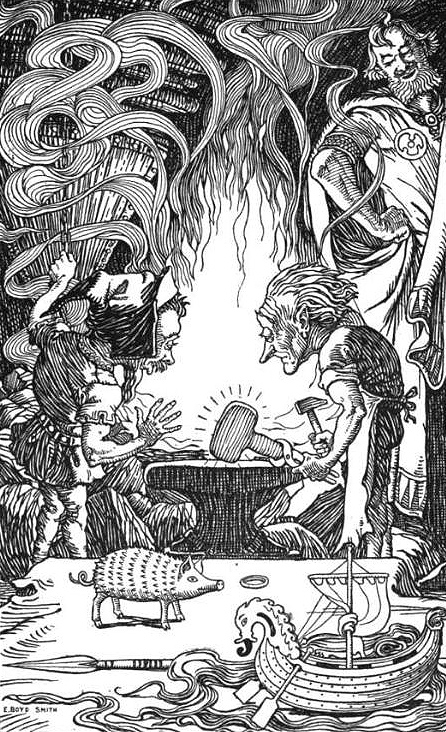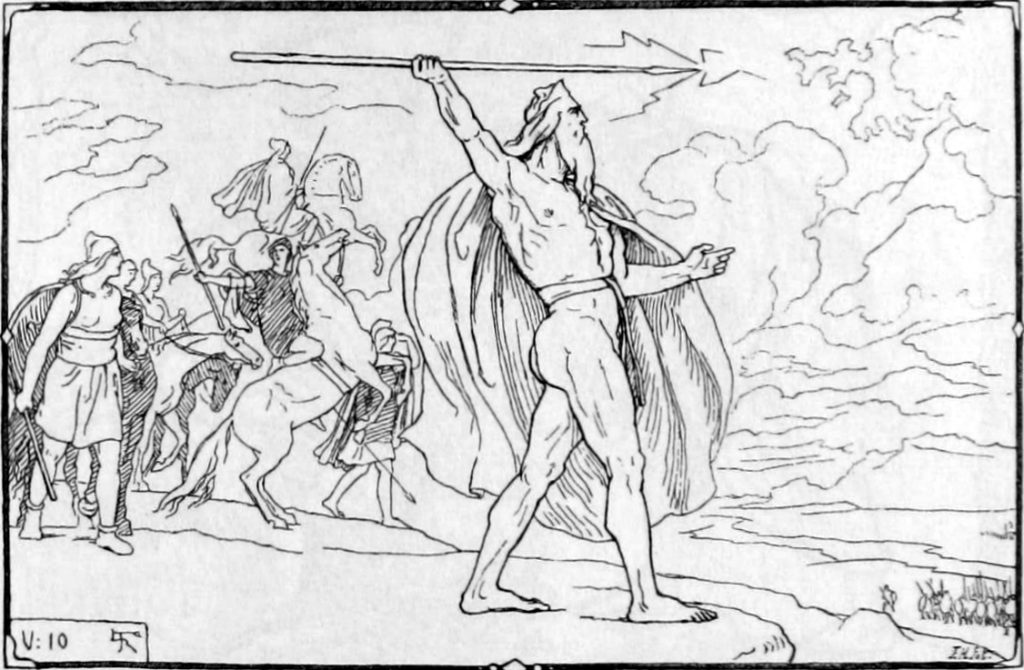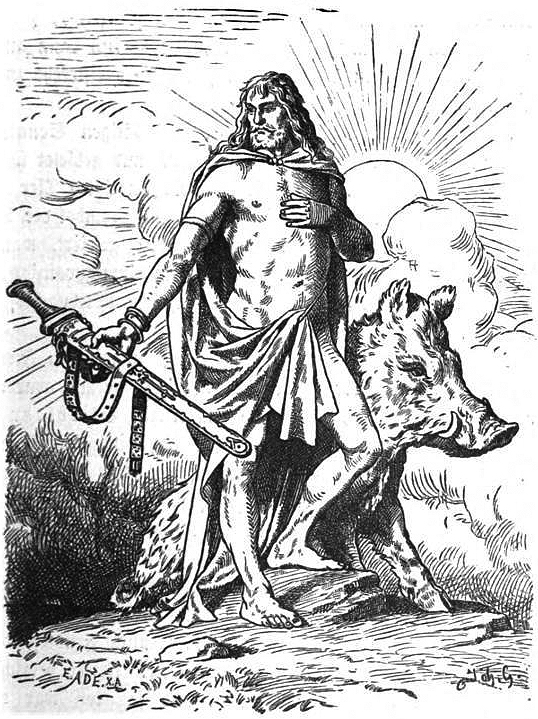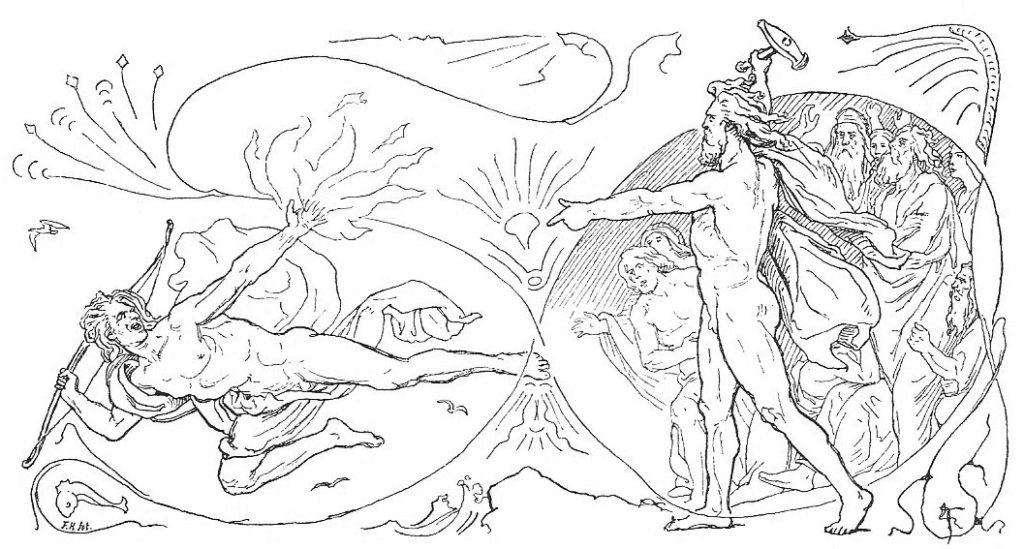The treasures of the gods in Norse mythology were six valuable items created by the dwarves, also called dark elves. These treasures were made by Brokk, Eitri, and two dwarf brothers known as the Sons of Ivaldi after Loki cut Sif’s hair.
The origin of the treasures of the gods is an interesting tale from the Norse sagas that starts with a prank. The trickster god Loki is at the center of the incident that sent him to Svartalfheim, the realm of the dark elves. There, he convinced the Sons of Ivaldi, as well as dwarf brothers Brokk and Eitri, to create gifts he could take to the Æsir gods to make amends.
But nothing Loki did was without an ulterior motive. Loki enticed the dark elves into doing his bidding with a wager. Whichever pair made the best treasure would win Loki’s head. What started with cutting Sif’s hair would end with broken promises and Loki’s lips sewn shut.
What were the Treasures of the Gods?
The treasures of the Gods were 6 precious items made by the Sons of Ivaldi and dwarf brothers Brokk and Eitri. These treasures were Sif’s golden hair, Thor’s hammer Mjölnir, Odin’s spear Gungnir, Freyr’s ship Skidbladnir, Odin’s arm-ring Draupnir, and Freyr’s golden boar Gullinbursti.
The dark elves made more items for the Norse gods, but these 6 are collectively considered the treasures of the gods.
The Sons of Ivaldi created the first three treasures:
- Sif’s golden hair
- Odin’s spear Gungnir
- Freyr’s ship Skidbladnir
Instead of leaving the caves of Svartalfheim and returning to Asgard, Loki wanted more. He bet the dwarf brothers Brokk and Eitri (also known as Sindri) that they couldn’t make anything as valuable as the three treasures created by the Sons of Ivaldi.
Brokk and Eitri created three treasures in response:
- Odin’s arm ring Draupnir
- Freyr’s golden boar Gullinbursti
- Thor’s hammer Mjölnir

What happened to Sif’s Golden Hair?
Loki cut Sif’s hair as a prank while she and her husband Thor were sleeping. But Loki didn’t just cut her hair. Loki plucked every last strand from Sif’s head, ensuring that Sif’s hair would never grow back. Furious, Thor threatened to kill Loki, but Loki promised to replace Sif’s hair with something even more valuable.
Loki left Asgard, traveling to Svartalfheim, one of the nine worlds of Norse mythology. Svartalfheim is sometimes called Nidavellir, where the dark elves (dwarves) live in deep caves within the mountains. He approached the Sons of Ivaldi, asking them to fashion a replacement for Sif’s hair.
The Sons of Ivaldi went to work, creating a glorious golden hair piece made from the finest spun gold. When Loki saw how quickly the dark elves could make Sif’s hair piece, he decided to ask them for more treasures. They agreed, creating the ship Skidbladnir and the spear Gungnir.
What did the Ship Skidbladnir do?
Freyr’s ship Skidbladnir was a magical vessel created by the Sons of Ivaldi. Skidbladnir always found favorable winds and could be folded like a paper boat small enough to fit in Freyr’s hand. The ship Skidbladnir could comfortably hold all of the Norse gods and their gear when unfolded.
Skidbladnir means “made from thin pieces of wood” in Old Norse. The ship Skidbladnir is considered the greatest ship of all time. Not only does this famed ship appear in the Poetic Edda, the Prose Edda, and Heimskringla, but Skidbladnir is also the subject of countless classical and contemporary art.
How did Odin’s Spear Gungnir work?
Odin’s spear, Gungnir, was a powerful weapon. Thrown from any distance, the spear would hit its mark. Once it plunged into the target, the spear Gungnir would return to the hand that threw it without fail.
One special thing about Gungnir was that it didn’t matter who threw the spear; it would hit its mark every time and from any distance. Magic runes carved into the spear gave Gungnir its power.
The strength and skill of the wielder didn’t matter. Wherever the spear Gungnir was sent, it would go swiftly and without missing the target.

Was the Arm Ring Draupnir magical?
Draupnir was a magic arm ring made from pure gold. In Norse mythology, gold symbolizes allegiance and renewal. Every ninth night, Draupnir produced eight identical gold rings the same size and weight of itself.
The arm-ring Draupnir often appears in Norse sagas. When Odin’s beloved son Baldr is killed, Odin places the ring on Baldr’s funeral pyre. Draupnir is retrieved by Odin’s son Hermod. Later, Freyr used Draupnir to woo the giantess Gerd, who he eventually married.
Which of the Norse Gods did the Golden Boar Gullinbursti belong to?
The golden boar called Gullinbursti was given to the god Freyr. Gullinbursti wasn’t just any boar. Made from pure gold, Gullinbursti was said to shine so brightly that night became day in his presence. Freyr rode Gullinbursti like a horse, and the golden boar was said to be faster on air or land than any horse except for Sleipnir.
Gullinbursti means “golden mane,” a reference to the glorious golden bristles along his neck. Brokk and Eitri created Gullinbursti from thin strands of gold wire cut into hundreds of tiny pieces and a piece of pig skin.
They placed the materials in the forge, pumping the bellows to keep the fire hot despite Loki’s attempt to sabotage the pair. When they pulled their creation out of the forge, Gullibursti emerged.

What was special about Thor’s Hammer Mjölnir?
Thor’s hammer, Mjölnir, was the strongest weapon in Asgard. It was unbreakable and could defeat the giants, who were the Æsir’s mortal enemies. Mjölnir also carried magic that could be used to revive living things. Thor once used Mjölnir’s power to bring his two favorite goats back from the dead.
Mjölnir was a divine instrument and a weapon of destruction. It was said to bestow blessings upon whoever wielded it. When Thor was slain during Ragnarök, Mjölnir was passed down to his sons Modi and Magni.
Because of its powerful symbolism in Norse mythology, Vikings often wore pendants of Mjölnir around their necks.

How did the Norse Gods decide who won Loki’s wager?
Loki made a wager with the dwarves, offering his head to whoever made the greatest gift for the gods. The gods decided that Mjölnir was the best of the treasures, so Brokk and Eitri won the wager for Loki’s head. Of course, Loki didn’t make good on the wager, arguing that cutting off his head would injure his neck. Since the wager only included Loki’s head and not his neck, Loki could use this loophole to avoid paying Brokk and Eitri.
But Brokk wasn’t willing to let Loki go unscathed. After all, Loki had tried to sabotage the smithies at every turn, even turning into a gadfly and biting Brokk and Eitri while they worked.
So Brokk took his brother’s awl and a thin leather thong, sewing Loki’s lips together.

